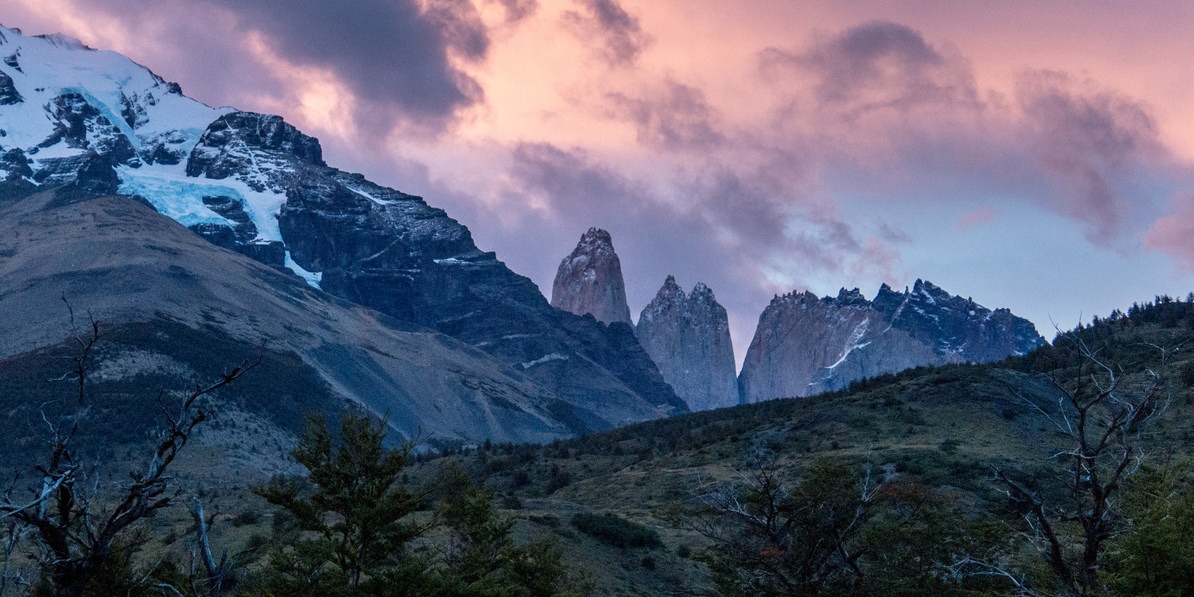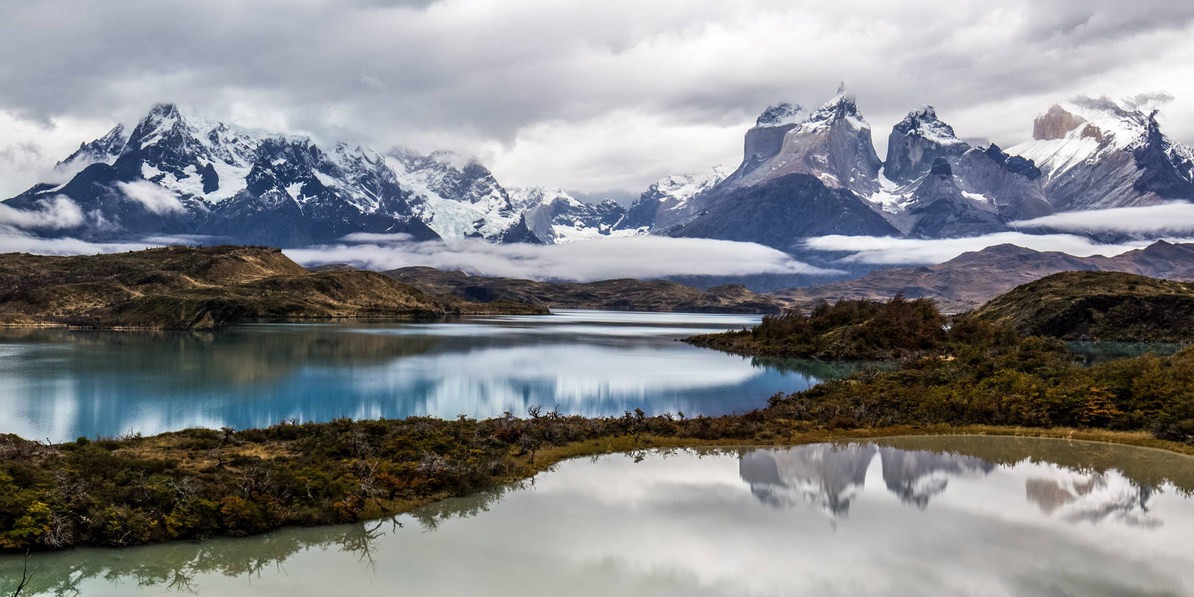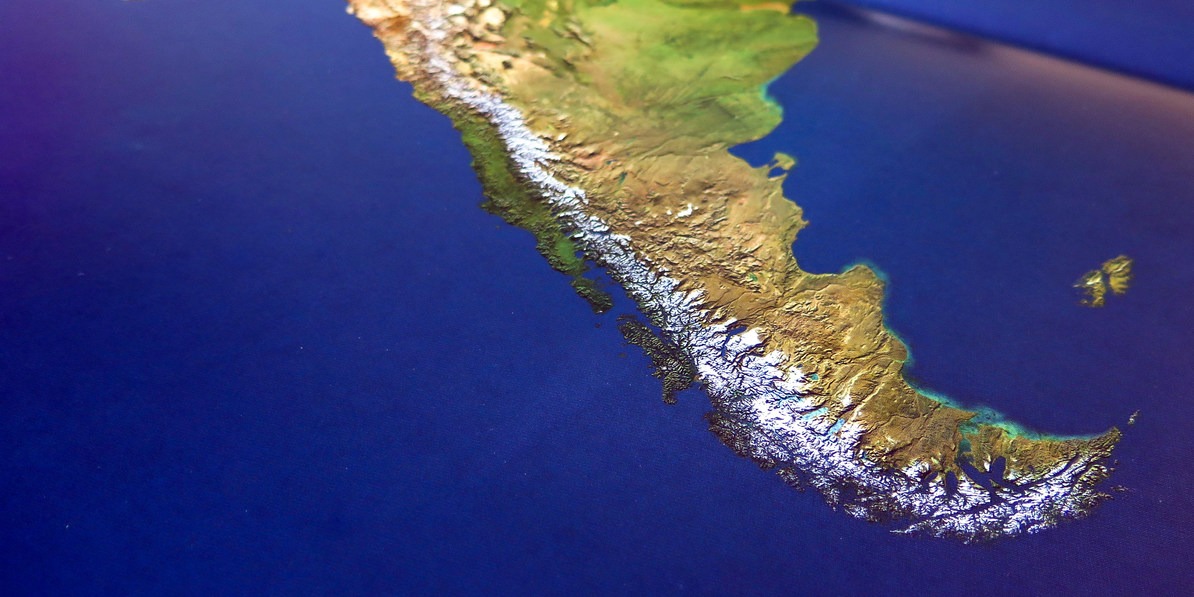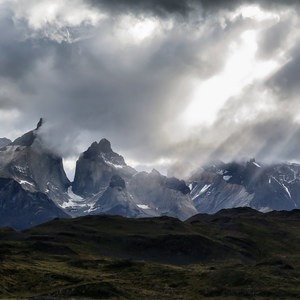Patagonia. The name ignites the imagination, a shorthand for earthly extremes and harsh, barren terrain. Whether you first encountered Patagonia on an outdoor clothing label or in Bruce Chatwin's classic travel memoir In Patagonia, the idea of this wind-swept landscape dangling at the end of the world lodges in your brain and burrows deep, a wildness that calls to your inner wanderer. Patagonia. You can picture early cartographers filling it with dragons as their imaginations pondered those vast, empty spaces on the map. But what actually lurks in those far-off mountains? Some of the most spectacular adventure destinations on the planet. Here are a few that should push you over the edge to finally book that plane ticket.
The W Trek in Torres del Paine National Park, Chile

The Torres del Paine viewed from the lodges at Torre Central. Photo by Basil Newburn.
The signature adventure in Patagonia’s leading destination, The W Trek is one of the world’s truly great hikes and an enduring item on bucket lists of legions of adventurers. Even if you don’t know the park’s famous Cuernos del Paine by name, you have almost certainly seen photos of their iconic peaks. They are the Half Dome of Patagonia: striking, unmistakable, and emblematic of a region blessed with visual riches.

The Cuernos del Paine. Photo by Kat Dierickx.
The Cuernos are a highlight on the 55-mile W Trek, named for the shape of the trail as it reaches into three neighboring valleys in the Paine massif, which also features Glaciar Grey, the Valle Francés, and the namesake Torres del Paine (Paine Towers) themselves. In sheer variety, Torres del Paine National Park is nearly unrivaled, leading visitors among mountains, glaciers, lakes, rivers, forests, and plains. And the park, though remote, is well traveled, well maintained, and accessible to adventure seekers with varying ability and experience. Torres del Paine may be reached via airports in either El Calafate, Argentina or Punta Arenas, Chile.
The Fitz Roy range near El Chaltén, Argentina

Fitz Roy watches over Lago de los Tres. Photo by Shane O'Hara.
Made famous by the Patagonia brand logo, the Fitz Roy range has become the symbol of Patagonian mountains. A series of sharp, technical peaks, the Cordillera Fitz Roy offers several challenges (first among them Cerro Fitz Roy itself, also called Cerro Chaltén) that are career objectives for some of the most skilled alpinists in the world. The series of needle-like peaks, called agujas, was not climbed in sequence until 2014 when American climbers Tommy Caldwell and Alex Honnold completed a project called the Fitz Traverse. Names like Aguja Saint-Exupéry, Aguja Mermoz, and Aguja Guillaumet will be familiar to readers of Antoine de Saint-Exupéry’s Wind, Sand, and Stars, a wonderful adventure book ranked among National Geographic’s Top Ten.
For the mortals among us, the Fitz Roy/Chaltén region also offers unforgettable adventures that do not require mountaineering expertise. The standard Fitz Roy hiking circuit covers approximately 40 miles of well-marked, moderate trails that provide stunning views of the peaks. Many consider the hiking to be somewhat easier than Torres del Paine, but the weather is usually worse: Prepare for wind, cold, and precipitation. Access is convenient through the new international airport in El Calafate, Argentina, with regular coach service to the town of El Chaltén. The Fitz Roy region is popular, though perhaps not quite as crowded as Torres del Paine.
Tierra del Fuego, Chile and Argentina

Armchair adventurers and compulsive atlas browsers can't help but be drawn to the extreme geographic position of Tierra del Fuego, bottom right. Photo by Basil Newburn.
The end of the end of the world, Tierra del Fuego (“Land of Fire”) sits at the very tip of the South American continent. The capital, Ushuaia, is the southernmost city in the world and the most common port for departures to Antartica. Well-known adventure destinations in this remote moonscape include Tierra del Fuego National Park on the Argentine side of Isla Grande de Tierra del Fuego as well as Isla Navarino, home to the demanding 33-mile Dientes de Navarino Trek. For ambitious hikers looking to dial up the foreboding and the solitude, Navarino might be just the ticket: sketchy trails, challenging navigation, punishing weather, exposed passes… and jaw-dropping vistas not likely to be shared by your hiking buddies back home.
Parque Patagonia, Chile

Guanaco in Parque Patagonia. Photo by Shane O'Hara.
Parque Patagonia is the creation of Doug and Kris Tompkins, American philanthropists on a mission to preserve wild treasures in Patagonia. Doug founded The North Face in 1966 and Esprit Clothing in 1968, making a fortune that allowed the pair to eventually undertake one of the largest private conservation efforts in the world. Since the early 1990s, the Tompkins team has purchased over 2 million acres of land in Chile and Argentina with the intention of establishing national parks and giving them back to the people of these regions. Parque Patagonia, centered on the scenic Valle Chacabuco, is one of the crown jewels of this system. Formerly a sheep ranch, the 650,000-acre park is undergoing intensive restoration projects to bring back the natural grasslands of the region and the local wildlife that comes with them. For North American adventurers familiar with established, 100-year-old national parks, Parque Patagonia is a rare opportunity to see a land in transition from agriculture to nature reserve. Several gorgeous hiking trails have already been established, and more are being constructed all the time. Enjoy the adventure of being one of the earliest visitors to this new park while also looking for ways to support a well-intentioned conservation cause.
Los Glaciares National Park, Argentina

Glaciar Perito Moreno in Los Glaciares National Park. Photo by Kat Dierickx.
Los Glaciares is the largest national park in Argentina, covering 2,806 square miles, 30% of which are covered in ice. The park gets its name from the 47 glaciers that are embedded in the Patagonian Andes. The most impressive of these are the Upsala, Onelli and Perito Moreno Glaciers. These glaciers feed two lakes: Lago Argentino to the north, the largest lake in Argentina, and Lago Viedma to the south. The incredible beauty of the landscape is on full display where the Perito Moreno Glacier meets Lago Argentino; here an elevated boardwalk provides tourists with impressive views of the huge glacier wall. The front of the Perito Moreno Glacier can be up to 120 feet high, and it is constantly moving. If you stay long enough, you just might see a huge section of the glacier plummet into the lake below. For a closer look at the glacier, there are long and short glacier trekking options available. The park was established in 1937 and made a UNESCO World Heritage Site in 1981.






Comments
Sign In and share them.